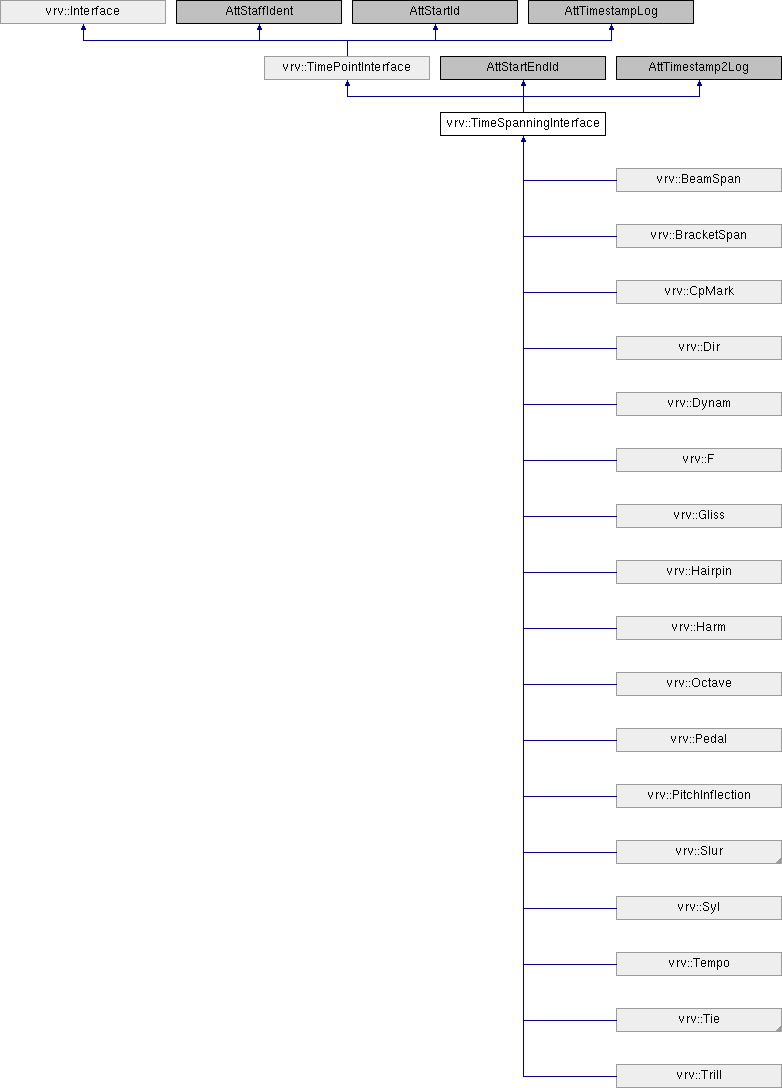 |
Verovio
Source code documentation
|
 |
Verovio
Source code documentation
|
This class is an interface for spanning elements, such as slur, hairpin, etc. More...
#include <timeinterface.h>

Public Member Functions | |
| bool | SetStartAndEnd (LayerElement *element) |
| bool | HasStartAndEnd () const |
| bool | IsSpanningMeasures () const |
| Return true if the element is spanning over two or more measures. | |
| void | SetIDStr () |
| void | GetCrossStaffOverflows (StaffAlignment *alignment, curvature_CURVEDIR curveDir, bool &skipAbove, bool &skipBelow) |
| Check if the slur or tie needs to be taken into account as overflow above or below in case of cross-staff end points. More... | |
Constructors, destructors, reset methods | |
Reset method resets all attribute classes | |
| TimeSpanningInterface () | |
| virtual | ~TimeSpanningInterface () |
| void | Reset () override |
| Virtual reset method. More... | |
| InterfaceId | IsInterface () const override |
| Virtual method returning the InterfaceId of the interface. More... | |
Set and get the first and second LayerElement | |
The setter asserts that no LayerElement was previously set. | |
| void | SetEnd (LayerElement *end) |
| LayerElement * | GetEnd () |
| const LayerElement * | GetEnd () const |
| Measure * | GetEndMeasure () |
| Return the end measure of the TimePointInterface. | |
| const Measure * | GetEndMeasure () const |
| bool | IsOrdered () const |
| Check if the end points are temporally ordered @Return true if end temporally occurs after start. | |
| bool | IsOrdered (const LayerElement *start, const LayerElement *end) const |
| FunctorCode | InterfacePrepareTimeSpanning (PrepareTimeSpanningFunctor &functor, Object *object) |
| We have functor code in the interface for avoiding code duplication in each implementation class. More... | |
| FunctorCode | InterfacePrepareTimestamps (PrepareTimestampsFunctor &functor, Object *object) override |
| FunctorCode | InterfacePrepareStaffCurrentTimeSpanning (PrepareStaffCurrentTimeSpanningFunctor &functor, Object *object) |
| FunctorCode | InterfaceResetData (ResetDataFunctor &functor, Object *object) override |
 Public Member Functions inherited from vrv::TimePointInterface Public Member Functions inherited from vrv::TimePointInterface | |
| bool | SetStartOnly (LayerElement *start) |
| Set first LayerElement by verifying it is the correct one. | |
| void | AddStaff (int n) |
| Add a staff n to the AttStaffident vector (if not already there) | |
| bool | HasStart () const |
| Return true if a start is given (@startid or @tstamp) | |
| bool | IsOnStaff (int n) const |
| Return true if the TimePointInterface occurs on the staff Looks that the parent staff if the using @stardid or at the @staff values. | |
| bool | VerifyMeasure (const Object *owner) const |
| Return true if the interface owner is encoded in the measure of its start element Display a warning if not. | |
| TimePointInterface () | |
| virtual | ~TimePointInterface () |
| void | SetStart (LayerElement *start) |
| LayerElement * | GetStart () |
| const LayerElement * | GetStart () const |
| Measure * | GetStartMeasure () |
| Return the start measure of the TimePointInterface. | |
| const Measure * | GetStartMeasure () const |
| std::vector< const Staff * > | GetTstampStaves (const Measure *measure, const Object *object) const |
| Return a vector of staves looking at the @staff attribute or at the parent staff of the @startid. | |
| std::vector< Staff * > | GetTstampStaves (const Measure *measure, const Object *object) |
| FunctorCode | InterfacePrepareTimePointing (PrepareTimePointingFunctor &functor, Object *object) |
| We have functor code in the interface for avoiding code duplication in each implementation class. More... | |
 Public Member Functions inherited from vrv::Interface Public Member Functions inherited from vrv::Interface | |
| void | RegisterInterfaceAttClass (AttClassId attClassId) |
| Method for registering an MEI att classes in the interface. | |
| std::vector< AttClassId > * | GetAttClasses () |
| Method for obtaining a pointer to the attribute class vector of the interface. | |
| Interface () | |
| virtual | ~Interface () |
Additional Inherited Members | |
 Protected Member Functions inherited from vrv::TimePointInterface Protected Member Functions inherited from vrv::TimePointInterface | |
| void | SetIDStr () |
| Extract the fragment of the start or end @xml:id if given. | |
 Protected Attributes inherited from vrv::TimePointInterface Protected Attributes inherited from vrv::TimePointInterface | |
| LayerElement * | m_start |
| std::string | m_startID |
This class is an interface for spanning elements, such as slur, hairpin, etc.
It is not an abstract class but should not be instantiated directly.
| void vrv::TimeSpanningInterface::GetCrossStaffOverflows | ( | StaffAlignment * | alignment, |
| curvature_CURVEDIR | curveDir, | ||
| bool & | skipAbove, | ||
| bool & | skipBelow | ||
| ) |
Check if the slur or tie needs to be taken into account as overflow above or below in case of cross-staff end points.
This methods assumes staff
to be greater for the staff below.
| FunctorCode vrv::TimeSpanningInterface::InterfacePrepareTimeSpanning | ( | PrepareTimeSpanningFunctor & | functor, |
| Object * | object | ||
| ) |
We have functor code in the interface for avoiding code duplication in each implementation class.
Since we are in an interface, we need to pass the object (implementation) to the pseudo functor method.
|
inlineoverridevirtual |
Virtual method returning the InterfaceId of the interface.
Needs to be overridden in child classes.
Reimplemented from vrv::TimePointInterface.
|
overridevirtual |
Virtual reset method.
Needs to be overridden in child classes.
Reimplemented from vrv::TimePointInterface.
Reimplemented in vrv::Trill.